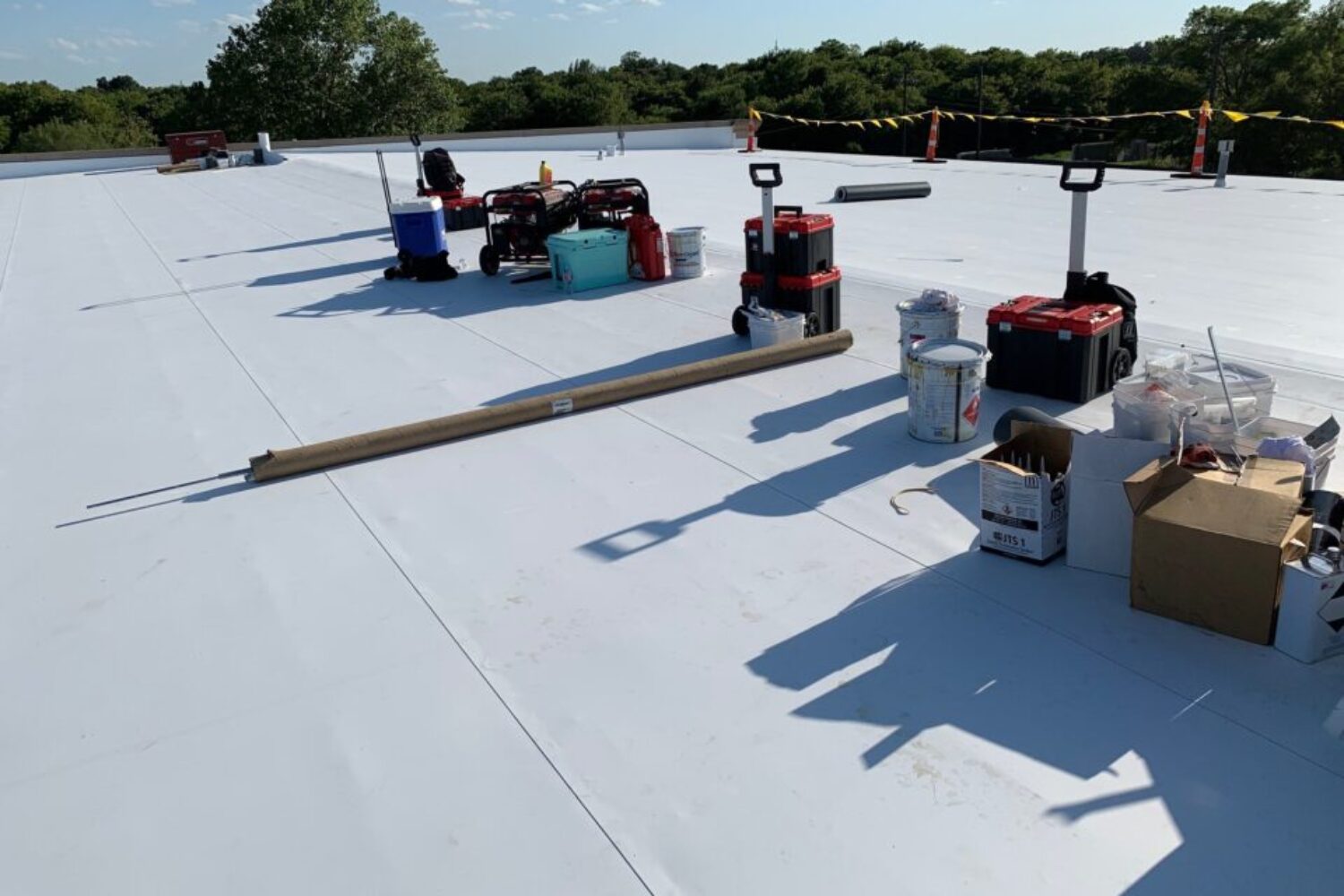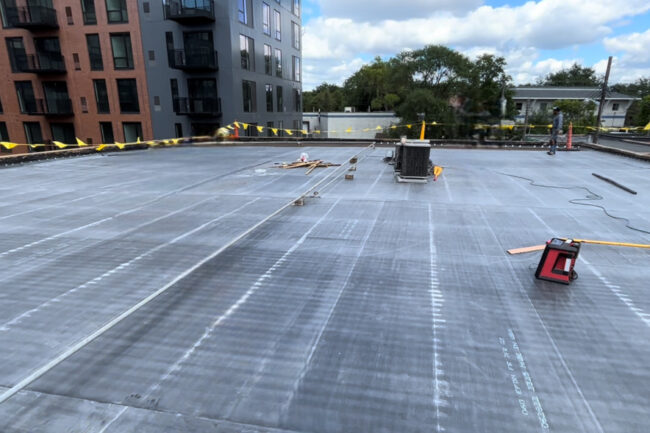Maybe you are looking to build or renovate your home and have noticed a trend in flat roof designs. Or maybe you are looking at commercial property construction, where flat roofs are often standard. Either way, there are some advantages to flat or low slope roofs that make it an attractive option. But, like most construction design choices, flat roofs have disadvantages too. Let’s take a look at flat roof pros and flat roof cons to fully understand the ins and outs of this construction design option.
Flat Roof Basics
Before jumping into flat roof pros and cons, let’s cover some flat roof basics. A flat roof is not completely flat. It has a low slope between ¼ to ½ an inch per foot. Compared to other roof types this is very low, but it does somewhat allow water to drain from the roof surface. When looking at the roof from the ground, however, this low slope looks flat.
Flat or low slope roofs hold water and snow longer than a standard sloped roof and require different construction materials and methods to prevent leakage. Flat roofs are constructed using a continuous surface, instead of the overlapping shingles or tiles used for sloped roofs. This method allows a low slope roof to hold standing water for a limited time without causing damage.
Flat or low slope roofing systems include:
- Membrane or single-ply
- Built-up roofing
- Modified bitumen
Membrane or single-ply is built with a bottom layer of insulation board covered with sheets of rubber or plastic that is fitted and secured in place. This method is most common for residential construction.
Built-up roofing is an older method used mostly in commercial buildings. It is constructed using many layers of materials built on top of one another, much as the name suggests. A bottom layer of insulation board is covered with several layers of asphalt and roofing felt, followed by a finishing layer of gravel.
Modified bitumen is a newer method used more often than built-up roofing for commercial buildings. It uses a flexible continuous sheet of material similar to an asphalt shingle that can be rolled onto the roof. It makes this method lighter weight than traditional built-up roofing.
Some flat roof pros and flat roof cons are specific to the method and materials used in constructing a low slope roof. These methods and materials can affect cost, maintenance, and lifespan.
The Pros of Flat Roofs
Flat Roof Costs
One of the main advantages of flat roofs is their affordability. Low slope roof costs are lower than other roof types because their installation is faster and easier and their materials are usually cheaper. Labor costs are also usually lower because flat roofs are less risky to install than sloped roofs. Cheaper construction costs is one of the reasons this type of roofing is often used on less expensive outbuildings or large commercial structures.
Maintenance and Repair Costs
The lower material and labor costs of flat roofs carry over to lower maintenance and repair costs too. Overall, a flat roof usually sustains less damage over its lifespan than sloped roofs, especially in less severe climates where snow is not as common. Flat roofs are also safer and easier to inspect and repair. Routine maintenance, such as gutter cleaning, is also less demanding with a low slope roof.
Added Space
Flat roofs add usable space to your home or business. This can include something as simple as having an air conditioning unit or satellite located on the roof instead of the ground. Or something as elaborate as an outdoor living area, such as a rooftop deck or garden. Roof deck construction has become a popular add on for residential living spaces that incorporate flat roof designs.
Added space provided by flat roofs is not limited to the exterior. Flat roof designs also add usable square footage inside a building. Top floors do not have the typical constraints that come with the slanted walls created by sloped roofs. This can give low-sloped roofs architectural design options that are unavailable with higher pitched roofs.
The Cons of Flat Roofs
Covering flat roof pros is only half the equation when it comes to understanding flat or low slope roof construction. The other half of the equation covers the flat roof cons
Drainage Problems
One of the main flat roof problems is their poor drainage. Even though they are constructed with methods and materials that can withstand some standing water, this low slope roof problem is difficult to get around. They just do not drain water as efficiently as sloped roofs and water can easily pool, causing roofing material to break down. Water removal can also be time-consuming and costly.
Flat Roof Lifespan
One of the drawbacks of flat roofs is their limited lifespan, mostly due to the materials that are available for flat roof construction. Low slope roofs can be expected to last between ten to 15 years, which is about half the lifespan of most high-sloped roofs. This drawback of low slop roofs can make them more expensive over time, even though their upfront and maintenance costs are lower. Understanding the limitations of a low slope roof lifespan before making this construction design choice is important.
Flat Roofs in Winter
Low slope roofs in winter can be difficult, which can add to flat roof maintenance costs in more severe climates. Low slope roof maintenance can be demanding when heavy snow accumulates on a flat roof. This added weight can damage the roof and even cause collapse. Removing the snow is imperative to avoid excessive accumulation.
Low slope roofs are also more difficult to construct with adequate insulation, which can be a drawback in climates with extreme temperature changes.
Energy Efficiency: A Flat Roof Pro and a Flat Roof Con
Low sloped roofs can be more energy efficient than standard sloped roofs because of the potential of their large surface area to be covered with reflective material. This reflection can make flat roof heat absorption lower in the summer.
Flat roofs also use less construction material than sloped roofs, giving them a smaller carbon footprint. Adding energy efficient solar panels to a flat roof is also much easier and less costly than roofs with a higher pitch. Solar panels are also much less visible from the ground on low sloped roofs.
However, as mentioned above, sloped roofs have better insulation properties than flat roofs as well as better ventilation and airflow. These advantages of sloped roofs can make them more energy efficient than flat roofs.
The Final Word on Flat or Low Slope Roofs
Looking at flat roof pros gives you a good idea of why you would want to use this option in your construction project. Flat or low slope roofs are usually less expensive, more energy efficient, and can add usable space and interesting architectural options to your building. These flat roof pros though do need to be weighed with the flat roof cons. Mainly, the limited lifespan of flat roofs along with their drainage issues and problems with extreme temperatures and snow build up. These flat roof cons cannot be overlooked.
In the end, weighing your construction needs alongside these flat roof pros and flat roof cons will hopefully give you a clearer idea of what choice is best for your upcoming project.


